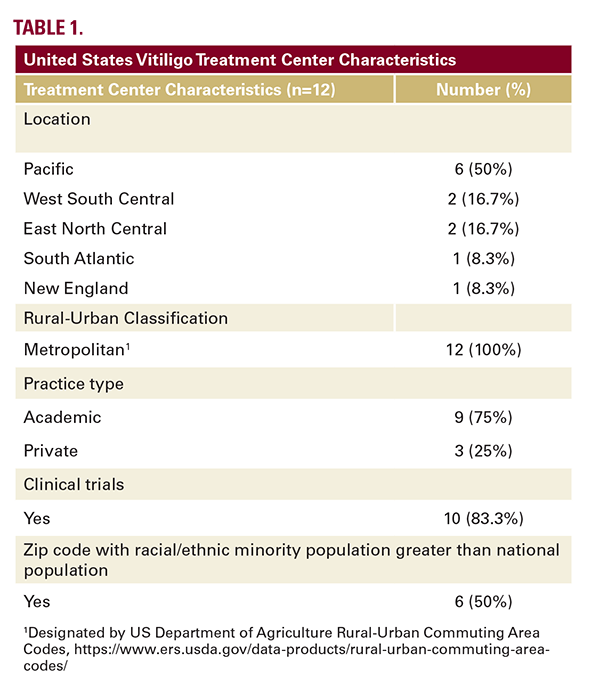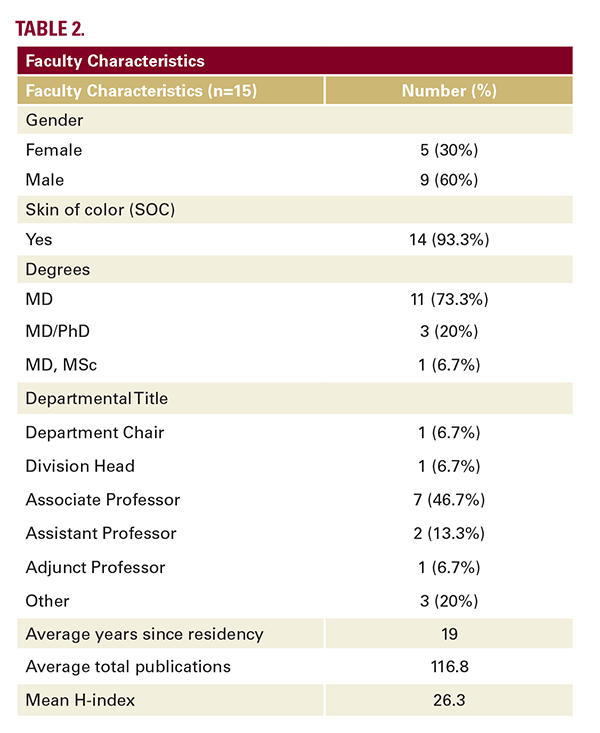To the Editor:
Specialized vitiligo treatment centers are instrumental in providing comprehensive care and advancing research for individuals with vitiligo. There is a paucity of literature characterizing the demographics, practice setting, and research impact of vitiligo treatment centers. This study sought to characterize the current landscape of these specialized centers.
The Global Vitiligo Foundation (GVF) website was used to identify United States (US) and international vitiligo treatment centers and affiliated faculty.1 US centers were further analyzed using their institutional website. The racial/ethnic composition of each center’s region was obtained using zip code data from the US Census. Additionally, whether centers led clinical trials was determined using the clinicaltrials.gov website. For each physician, affiliated institutions, departmental titles, demographics, and years since completing residency were collected. Finally, research productivity was assessed by the
Specialized vitiligo treatment centers are instrumental in providing comprehensive care and advancing research for individuals with vitiligo. There is a paucity of literature characterizing the demographics, practice setting, and research impact of vitiligo treatment centers. This study sought to characterize the current landscape of these specialized centers.
The Global Vitiligo Foundation (GVF) website was used to identify United States (US) and international vitiligo treatment centers and affiliated faculty.1 US centers were further analyzed using their institutional website. The racial/ethnic composition of each center’s region was obtained using zip code data from the US Census. Additionally, whether centers led clinical trials was determined using the clinicaltrials.gov website. For each physician, affiliated institutions, departmental titles, demographics, and years since completing residency were collected. Finally, research productivity was assessed by the

number of publications and H-index obtained through Scopus. A total of 35 vitiligo treatment centers were identified in the US (n=12), Egypt (n=10), Brazil (n=6), India (n=4), Mexico (n=1), and Australia (n=2). All 12 US centers were in metropolitan areas according to the U.S. Department of Agriculture’s Rural-Urban Commuting Area Codes. Half of the centers were in areas with more racial/ethnic minorities than the national population. Most centers (75%) were in academic settings, and the majority (83.3%) conducted clinical trials.
Among the US centers, 15 affiliated physicians were identified, all associated with academic institutions. Nearly two-thirds of the faculty were male (Table 2). Notably, all but one were individuals of color. Although the prevalence of vitiligo is similar across racial/ethnic groups, the impacts of vitiligo differ based on skin color and cultural factors.2,3 Individuals with darker
Among the US centers, 15 affiliated physicians were identified, all associated with academic institutions. Nearly two-thirds of the faculty were male (Table 2). Notably, all but one were individuals of color. Although the prevalence of vitiligo is similar across racial/ethnic groups, the impacts of vitiligo differ based on skin color and cultural factors.2,3 Individuals with darker







